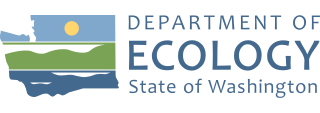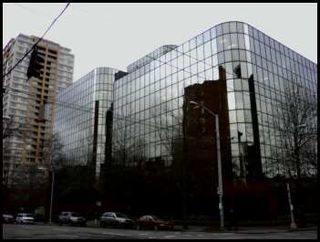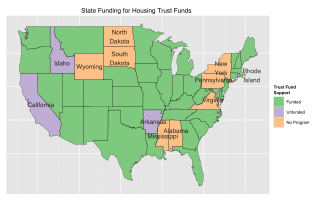In the U.S. state of Washington, a public development authority (most commonly PDA; also known as a public corporation) is a government-owned corporation. They are established under RCW 35.21.730. [1]
For example, the city of Seattle has numerous PDAs: the Burke Gilman Place PDA, Community Roots Housing, Historic Seattle PDA, Museum Development Authority, Pacific Hospital PDA, Pike Place Market PDA, Seattle Chinatown/International District PDA, 4Culture, and the Seattle Indian Services Commission. [2] Examples from elsewhere in the state include a PDA that oversees the Meydenbauer Center, a performing arts venue in Bellevue, Washington and the Hurricane Ridge Public Development Authority, created by the city of Port Angeles, Washington to develop and oversee the Hurricane Ridge Ski and Snowboard Area. [1]
A PDA is legally separate from the city or county that establishes it. Under state and federal law, all PDA contracts must specify that liabilities incurred by the corporation must be satisfied exclusively from their own assets. According to the City of Seattle, "This allows accomplishment of public purpose activities without assuming them into the regular functions of City government." Each Seattle PDA is governed by a volunteer council that oversees PDA activities and staff. [2]
There are 281 municipalities in the U.S. state of Washington. State law determines the various powers its municipalities have.
New York state public-benefit corporations and authorities operate like quasi-private corporations, with boards of directors appointed by elected officials, overseeing both publicly operated and privately operated systems. Public-benefit nonprofit corporations share characteristics with government agencies, but they are exempt from many state and local regulations. Of particular importance, they can issue their own debt, allowing them to bypass limits on state debt contained in the New York State Constitution. This allows public authorities to make potentially risky capital and infrastructure investments without directly putting the credit of New York State or its municipalities on the line. As a result, public authorities have become widely used for financing public works, and they are now responsible for more than 90% of the state's debt.

The Washington State Public Disclosure Commission (PDC) is an agency of the Washington state government that regulates candidates, campaigns and lobbyists. It enforces the state's disclosure and campaign finances laws, and provides public access to information about lobbying activities, the financial affairs of elected and appointed public officials, and campaign contributions and expenditures.

The Washington State Department of Ecology is the state of Washington's environmental regulatory agency. Created in February 1970, it was the first environmental regulation agency in the U.S. predating the creation of the Environmental Protection Agency (EPA) by several months.
Connecticut shares with the five other New England states a governmental structure known as the New England town. From 1666 to 1960, Connecticut had a system of county governments, which each had limited powers given to it by the General Assembly. They were abolished by Public Act 152 in 1960. Connecticut also had a system of sheriffs' offices until October 2000, when those were also abolished.

Historic Seattle is a Seattle, Washington public development authority focused on preserving Seattle's architectural heritage. For many years, they issued a monthly online magazine, Preservation Seattle and are involved in advocacy and education.

Seattle Parks and Recreation is the government department responsible for maintaining the parks, open spaces, and community centers of the city of Seattle, Washington. The department maintains properties covering an area of over 6,200 acres (25 km2), which is equivalent to roughly 11% of the city's total area. Of those 6,200 acres (25 km2), 4,600 acres (19 km2) are developed.

Pike Place Market is a public market in Seattle, Washington, United States. It opened on August 17, 1907, and is one of the oldest continuously operated public farmers' markets in the United States. Overlooking the Elliott Bay waterfront on Puget Sound, it serves as a place of business for many small farmers, craftspeople and merchants. It is named for its central street, Pike Place, which runs northwest from Pike Street to Virginia Street on the western edge of Downtown Seattle. Pike Place Market is Seattle's most popular tourist destination and the 33rd most visited tourist attraction in the world, with more than 10 million annual visitors.
The Washington State Department of Information Services (DIS) was a Governor's Cabinet-level agency that provided information technology assistance to state and local agencies, school districts, tribal organizations, and qualifying nonprofit groups in Washington.

The Municipal Research and Services Center (MRSC) is a non-profit organization based in Seattle with a mission of "supporting effective local government in Washington through trusted consultation, research, training, and collaboration". Founded in 1934 and funded primarily through a state appropriation, most of MRSC's services are offered free of charge to local government employees and public officials of cities, counties, and some special purpose districts in the State of Washington. MRSC's expertise covers a wide range of subjects including municipal law, municipal finance, urban planning, public works, and public management.

Housing trust funds are established sources of funding for affordable housing construction and other related purposes created by governments in the United States (U.S.). Housing Trust Funds (HTF) began as a way of funding affordable housing in the late 1970s. Since then, elected government officials from all levels of government in the U.S. have established housing trust funds to support the construction, acquisition, and preservation of affordable housing and related services to meet the housing needs of low-income households. Ideally, HTFs are funded through dedicated revenues like real estate transfer taxes or document recording fees to ensure a steady stream of funding rather than being dependent on regular budget processes. As of 2016, 400 state, local and county trust funds existed across the U.S.

Gun laws in Washington regulate the sale, possession, and use of firearms and ammunition in the state of Washington in the United States.

The executive branch of the government of Puerto Rico is responsible for executing the laws of Puerto Rico, as well as causing them to be executed. Article IV of the Constitution of Puerto Rico vests the executive power on the Governor—whom by its nature forms the executive branch.
Business improvement districts in the United States (BIDs), also known as local improvement districts (LIDs), are United States special districts within a city that are overseen by a nonprofit entity. In the United States, business improvement districts are typically funded by an additional tax assessment, with the tax increase going toward improvements of the area.
4Culture is a tax-exempt public development authority (PDA), with a fifteen-member board of directors, who are nominated by the King County Executive and confirmed by the King County Council. A Public Development Authority is a public entity created by cities or counties to accomplish public purpose activities without assuming them into the regular functions of County government.
The law of Washington consists of several levels, including constitutional, statutory, regulatory and case law, as well as local ordinances. The Revised Code of Washington forms the general statutory law.
The City of Seattle Landmarks Preservation Board is responsible for designating and preserving structures of historical importance in Seattle, Washington. The board recommends actions to the Seattle City Council, which fashions these into city ordinances with the force of law. The board is part of the city's Department of Neighborhoods.
A public transportation benefit area, abbreviated as PTBA, is a type of public-benefit corporation for public transit operators in the U.S. state of Washington.
Pike Place Market is a public market in Seattle, Washington founded in 1907. Throughout its history, in spite of various challenges brought about by changing ordinances and planning initiatives, it has operated without major interruptions, making it one of the oldest continuously operated public farmers' markets in the United States. It was created when city councilman Thomas P. Revelle took advantage of the precedent of an 1896 Seattle city ordinance that allowed the city to designate tracts of land as public markets, and designated a portion of the area of Western Avenue above the Elliott Bay tideflats off Pike Street and First Avenue. The first building at the Market opened November 30, 1907. During the early 1920s, the north side of the Corner Market became known as the Sanitary Market, and the area developed into a social scene. A new ordinance forbidding farmers' stalls to be placed in the street resulted in proposals to move the market, but in 1921 council voted to retain the existing location and work on expanding in place.








